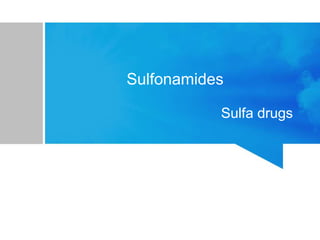sulfonamides.ppt
- 2. Contents ? History ? Mechanism of action ? Classification of Sulfonamides ? Orally absorbable sulfonamides ? Orally non absorbable sulfonamides ? Topical sulfonamides ? Adverse effect ? Drug interactions
- 5. ? inhibit enzyme dihydrofolate reductase Trimethoprim ? Analogue of trimethoprim Iclaprim ? inhibit dihudrofolate reductase ( affinity for protozoa) Pyremethamine
- 7. Orally Non absorbable agents Orally absorabable agents
- 8. Synergistic combination with sulfonamides sulfamethaxazole Trimethoprim Cotrimoxazole
- 9. Sulfadoxine Pyrimethamine Block protozoal folic acid synthesis
- 10. Antimicrobial Spectrum Active ? Gram negative bacilli ? E.coli, shigella, salmonella Moderately active ? Actinomycetes ? Rickettsiea
- 11. Resistance Mutation Overproduction of PABA Alteration in dihydropteroic acid syntetase Loss of permeability of sulfonamide Alternative pathway for PABA synthesis
- 12. Pharmacokinetics ? orally ? X IM/SC ? Topical ? IV Absorption ? Crosses BBB ? Accumulate in prostatic fluid ? Protein binding 85-93 % Distribution ? Acetylation in liver Metabolism
- 13. Clinical Uses ? Rarely used as single agent ? Topical sulfonamides- ulcerative colitis sulfamethaxazole Trimethoprim Cotrimoxazole
- 14. Indications of cotrimoxazole ? UTI°Øs ? Prostatitis ? Respiratory tract infection ? Typhoid ? Bacterial diarrheas and dysentery ? Nocardiosis ? Sexually Transmitted disease ? Pneumonia ? Melioidosis
- 16. Oral non absorbable sulfonamide ? Drug of choice- Ulcerative Colitis ? Absorb through GIT ? Degaded by Bacterial flora of colon 5-Amino Salicylic acid Sulfapyridine
- 17. Topical agents ? Trachoma(chlamydia) ? Bacterial conjunctivitis Sodium sulfacetamide ? Prevention of infection in burn cases ? Antimicrobial (Ag+) Silver Sulfadiazene ? Burn cases ? Active even in presence of pus Mafenide
- 18. Adverse effect Crystalluria and renal toxicity ?Less soluble in acidic urine ?Use of 3 sulfa drugs Hypersensitivity reaction ?Stevens Johnson syndrome ?Eosinophllia Kernictus in neonates ?Cross BBB Haemolytic anaemia ?Deficiency of glucose-6- phosphate dehydrogenase Cotrimoxazole fever Hypersensitivity Agranulocytosis


















